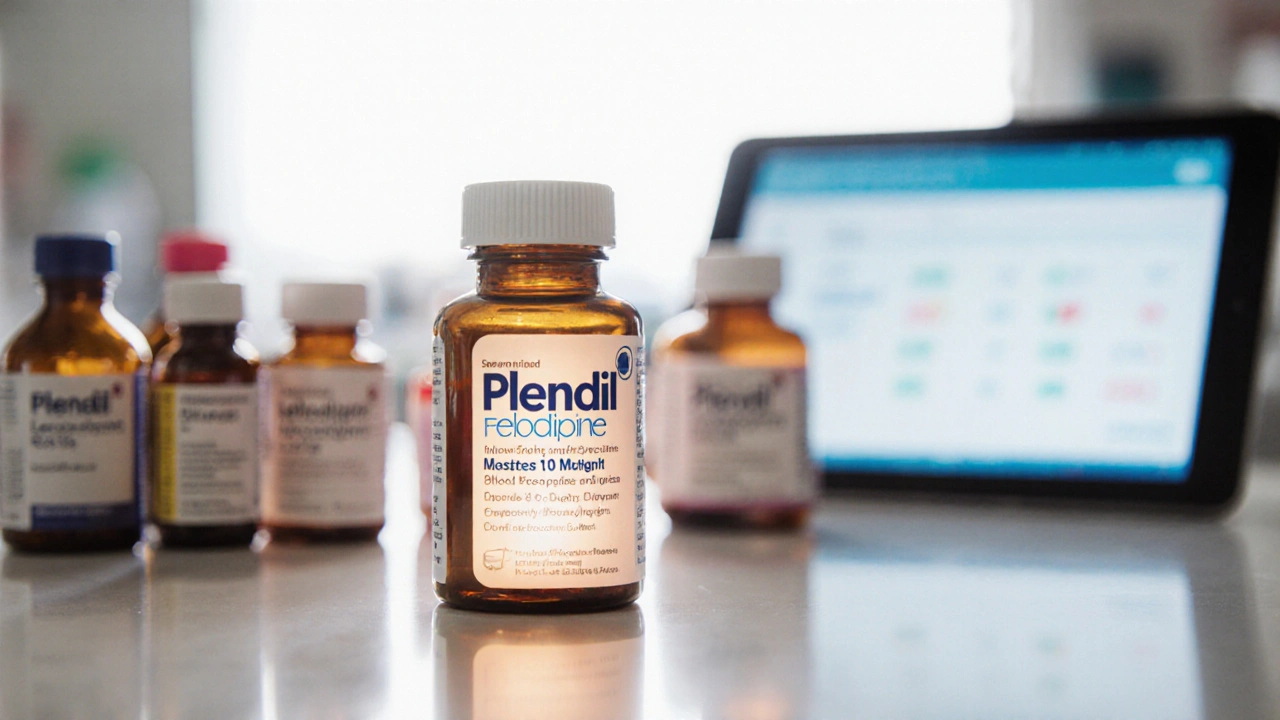Plendil (Felodipine) vs. Other Blood‑Pressure Drugs - A Practical Comparison
 Oct, 1 2025
Oct, 1 2025
Blood Pressure Drug Comparison Tool
| Drug | Class | Typical Dose | Key Benefits | Common Side Effects | UK Monthly Cost |
|---|---|---|---|---|---|
| Plendil (Felodipine) | Di-hydropyridine | 5-10 mg daily | Long-acting, low interaction | Edema, headache, flushing | £6-£12 |
| Amlodipine | Di-hydropyridine | 5-10 mg daily | Widely available, cheap | Peripheral edema, gum overgrowth | £4-£8 |
| Nifedipine ER | Di-hydropyridine | 30-60 mg daily | Strong BP drop | Tachycardia, dizziness | £7-£13 |
| Lercanidipine | Di-hydropyridine | 10-20 mg daily | Low edema risk | Headache, flushing | £9-£15 |
| Nicardipine ER | Di-hydropyridine | 40-80 mg daily | Good for high-risk patients | Edema, flushing | £12-£20 |
| Diltiazem | Non-di-hydropyridine | 120-240 mg daily | Controls heart rate | Bradycardia, constipation | £10-£18 |
| Verapamil | Non-di-hydropyridine | 80-240 mg daily | Reduces cardiac workload | Constipation, fatigue | £11-£19 |
When doctors prescribe a pill to steady your blood pressure, they often choose a drug that belongs to the calcium‑channel blocker family. Plendil is the brand name for felodipine, a third‑generation dihydropyridine that works by relaxing the smooth muscle in blood vessels. If you’ve been told to take Plendil-or you’re curious about other options-this guide lays out how it stacks up against the most common alternatives, what side‑effects to expect, and how to decide which pill fits your lifestyle.
Key Takeaways
- Plendil is a long‑acting, once‑daily calcium‑channel blocker with a low interaction profile.
- Alternatives such as amlodipine and lercanidipine offer similar efficacy but differ in cost and side‑effect windows.
- Non‑dihydropyridine blockers like diltiazem and verapamil affect heart rate as well as pressure-useful for certain arrhythmias.
- Choosing the right drug depends on age, kidney function, concurrent meds, and personal tolerance to side‑effects.
- Always involve your GP or pharmacist before swapping medicines.
What Is Plendil (Felodipine)?
Felodipine belongs to the dihydropyridine subclass of calcium‑channel blockers. It blocks L‑type calcium channels in the smooth muscle of arterial walls, preventing calcium influx that would otherwise cause contraction. The net effect is vasodilation, which lowers systemic vascular resistance and, consequently, blood pressure.
Typical dosing starts at 5mg once daily, with a maximum of 10mg for most adults. Because felodipine has a relatively long half‑life (≈12hours), steady plasma levels are achieved after a few days, allowing once‑daily dosing. The drug is metabolised mainly by CYP3A4, so strong inducers (e.g., rifampicin) can reduce its effectiveness, while inhibitors (e.g., clarithromycin) may raise blood levels.
Common side‑effects include peripheral edema, headache, and flushing. These usually subside after the first two weeks as the body adapts. Rarely, patients report dizziness or palpitations.
Top Alternatives to Plendil
Below are the most frequently prescribed drugs that serve the same purpose-controlling hypertension-grouped by chemistry and clinical profile.
1. Amlodipine
Amlodipine is another dihydropyridine, known for its once‑daily dosing and a relatively gentle side‑effect curve. It’s often the first‑line choice in the UK because of its low cost under the NHS.
2. Nifedipine (Extended‑Release)
Nifedipine in its extended‑release formulation mimics the long‑acting profile of felodipine but can cause more pronounced reflex tachycardia in sensitive patients.
3. Lercanidipine
Lercanidipine is a newer dihydropyridine with a very gradual onset, making it well‑tolerated for those who experience edema on other blockers.
4. Nicardipine (Extended‑Release)
Nicardipine offers a balance between potency and vascular selectivity, but it’s less widely prescribed due to higher price.
5. Diltiazem
Diltiazem belongs to the non‑dihydropyridine class. It not only dilates vessels but also slows the heart rate, making it useful for patients with concurrent atrial fibrillation.
6. Verapamil
Verapamil is another non‑dihydropyridine that can be chosen when a negative inotropic effect is desirable, such as in certain types of angina.
7. Hypertension (The Condition)
Hypertension is a chronic elevation of arterial pressure that increases the risk of stroke, heart disease, and kidney failure. Managing it involves lifestyle changes plus medication.

Side‑Effect Profiles at a Glance
| Drug | Class | Typical Dose | Key Benefits | Common Side‑Effects | UK Cost (per month) |
|---|---|---|---|---|---|
| Plendil (Felodipine) | Di‑hydropyridine | 5‑10mg daily | Long‑acting, low interaction | Edema, headache, flushing | £6‑£12 |
| Amlodipine | Di‑hydropyridine | 5‑10mg daily | Widely available, cheap | Peripheral edema, gum overgrowth | £4‑£8 |
| Nifedipine ER | Di‑hydropyridine | 30‑60mg daily | Strong BP drop | Tachycardia, dizziness | £7‑£13 |
| Lercanidipine | Di‑hydropyridine | 10‑20mg daily | Low edema risk | Headache, flushing | £9‑£15 |
| Nicardipine ER | Di‑hydropyridine | 40‑80mg daily | Good for high‑risk patients | Edema, flushing | £12‑£20 |
| Diltiazem | Non‑di‑hydropyridine | 120‑240mg daily | Controls heart rate | Bradycardia, constipation | £10‑£18 |
| Verapamil | Non‑di‑hydropyridine | 80‑240mg daily | Reduces cardiac workload | Constipation, fatigue | £11‑£19 |
How to Choose the Right Pill for You
Deciding whether to stay on Plendil or switch to another drug isn’t a one‑size‑fits‑all puzzle. Consider these practical factors:
- Age and Kidney Function: Older adults often experience more pronounced edema with dihydropyridines. Lercanidipine or a low‑dose amlodipine might be gentler.
- Concurrent Medications: If you’re on strong CYP3A4 inhibitors (like certain antifungals), felodipine levels could spike. A non‑CYP3A4 drug such as diltiazem may be safer.
- Heart‑Rate Concerns: For patients with atrial fibrillation or tachycardia, a non‑dihydropyridine (diltiazem or verapamil) offers dual control of pressure and rate.
- Cost Sensitivity: The NHS typically prefers amlodipine because it’s cheaper. If budget matters, compare the monthly price column in the table.
- Side‑Effect Tolerance: If peripheral edema is a deal‑breaker, try lercanidipine which has a lower incidence.
Speak to your GP or pharmacist with this checklist. They can run basic blood tests (renal function, liver enzymes) and adjust the dose accordingly.
Switching Safely: What to Expect
Never stop a blood‑pressure pill abruptly. A typical switch involves:
- Doctor reviews your latest BP reading and labs.
- New drug is started at a low dose while the old one is tapered over 2‑3 days.
- Blood pressure is monitored daily for the first week.
- If the new drug causes troublesome side‑effects, the doctor may revert or try another alternative.
Keep a log of any new symptoms-headaches, swelling, dizziness-so you can report them accurately.
Frequently Asked Questions
Can I take Plendil with a statin?
Yes. Felodipine is metabolised by CYP3A4, and most statins (like atorvastatin) share the same pathway, but clinical data shows no major interaction at standard doses. Always confirm your exact regimen with a pharmacist.
Why does my ankle swell on Plendil?
Dihydropyridines dilate peripheral vessels, causing fluid to pool in the lower limbs. Raising your legs, reducing salt intake, or switching to a drug with less edema risk (like lercanidipine) can help.
Is felodipine safe during pregnancy?
Animal studies suggest risk, and human data are limited. Most guidelines advise using alternative antihypertensives (e.g., labetalol) during pregnancy. Discuss options with your obstetrician.
How quickly does Plendil lower blood pressure?
Significant reduction appears after 2-3 days, with full steady‑state effect reached in about a week. This timing is similar to most long‑acting calcium‑channel blockers.
Can I combine Plendil with an ACE inhibitor?
Combination therapy is common and often more effective than either drug alone. The duo works well because they act on different pathways. Your doctor will watch kidney function and potassium levels.
What should I do if I miss a dose?
Take the missed tablet as soon as you remember, unless it’s almost time for the next dose. In that case, skip the missed one-don’t double up.

Bottom Line
Plendil remains a solid choice for many patients, especially those who value once‑daily dosing and a predictable interaction profile. Yet alternatives like amlodipine, lercanidipine, and the non‑dihydropyridines offer nuanced benefits that can better match individual health profiles. Use the table and checklist above as a starting point, then have a focused chat with your healthcare provider. The right blood‑pressure pill can keep you feeling steady and lower your long‑term risk-so it’s worth getting it right the first time.

Patrick McCarthy
October 1, 2025 AT 15:40I was digging through the blood‑pressure comparison and the edema risk caught my eye. Felodipine’s long‑acting profile is great for people who want once‑daily dosing. The interaction note about CYP3A4 inhibitors seems especially useful for anyone on antifungals. It’s also handy that the UK cost sits between £6 and £12, which is a decent middle ground. Overall the table makes quick side‑effect scanning pretty painless.
Geraldine Grunberg
October 6, 2025 AT 12:28Wow, such a clear layout, really helpful, especially for those of us juggling multiple meds, and the cost breakdown, it’s priceless!
Elijah Mbachu
October 11, 2025 AT 09:16When I first switched from amlodipine to felodipine I was kinda nervous about the swelling thing. I read the table and saw that edema rates are similar, so I gave it a shot. The first week I felt a mild headache but it faded by day ten. My blood pressure dropped steadily and hit the target zone after about five days. I kept a simple log: morning reading, any foot puffiness, and how I felt overall. By the end of the second week the headache was gone and there was no noticeable ankle swelling. I think the gradual onset of felodipine helps the body adjust. I also liked that I didn’t have to worry about major drug interactions with my statin. The CYP3A4 note is good, but I’m not on any strong inhibitors, so I felt safe. My doctor appreciated the consistent BP numbers and kept me on the same dose. I didn’t need any extra lab work beyond the routine kidney check. The cost stayed within the £6‑£12 range, which fit my budget nicely. If you’re on a tight budget, the price is still reasonable compared to some newer agents. I’d say the main takeaway is to give felodipine a fair trial of at least two weeks. Patience and a bit of log‑keeping can really show you if it’s the right match for you.
Sunil Rawat
October 16, 2025 AT 06:04Thanks for sharing your experience, it really helps people see the real‑world side of felodipine.
Andrew Buchanan
October 21, 2025 AT 02:52Key points to consider: • Felodipine is metabolised by CYP3A4; avoid strong inducers. • Typical dose 5‑10 mg once daily. • Common side‑effects: edema, headache, flushing. • Price range £6‑£12 per month in the UK. • Suitable for patients without significant drug interactions.
Krishna Chaitanya
October 25, 2025 AT 23:40Whoa this looks like a recipe for drama in the bloodstream, the edema can really mess up your vibe!
diana tutaan
October 30, 2025 AT 19:28The comparison ignores the fact that felodipine can cause tachycardia in rare cases and the table glosses over the lack of head‑to‑head trials against newer agents.
Sarah Posh
November 4, 2025 AT 16:16Let’s remember that every drug has trade‑offs, and many patients do fine on felodipine when monitored properly.
Dion Campbell
November 9, 2025 AT 13:04Honestly, if one were to peruse the pharmacological literature, the nuanced pharmacokinetics of felodipine render it a superior choice for the discerning clinician.
Kyle Rhines
November 14, 2025 AT 09:52Sure, but you’re ignoring the hidden industry push for cheaper generics that may not meet the same bio‑equivalence standards.
Lin Zhao
November 19, 2025 AT 06:40I appreciate both the clinical data and the patient anecdotes 😊 – a balanced view helps us make better decisions.
Laneeka Mcrae
November 24, 2025 AT 03:28The facts are clear: felodipine offers comparable efficacy to amlodipine with a slightly better interaction profile. Its cost is modest, and the side‑effect spectrum is well‑known. However, individual tolerance varies, so clinicians should personalize therapy. Ultimately, the decision hinges on patient-specific factors.
Chris Fulmer
November 29, 2025 AT 00:16From a global perspective, the availability of multiple calcium‑channel blockers means we can tailor therapy to diverse patient populations, especially in low‑resource settings.
Dan Dawson
December 3, 2025 AT 21:04That’s a solid point.
Lawrence Jones II
December 8, 2025 AT 17:52When evaluating antihypertensive regimens, consider the pharmacodynamic synergy between CCBs and ACE inhibitors – it can achieve additive BP reduction without excessive reflex tachycardia 🩺💊.
Robert Frith
December 13, 2025 AT 14:40Well mate, the Brits will never admit amlodipine is better, but we all know the truth!